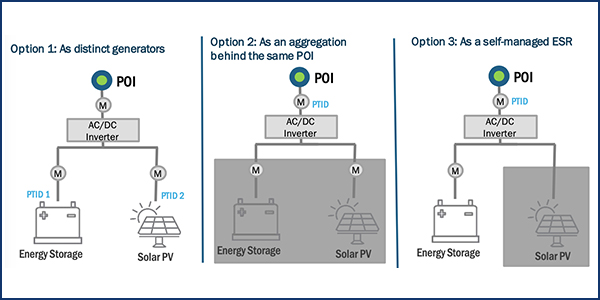By Michael Kuser
NYISO on Tuesday floated a plan that would provide hybrid storage resources (HSRs) three options for participating in its energy and capacity markets.
Kanchan Upadhyay and Amanda Myott, NYISO energy and capacity market design specialists, respectively, presented an overview of the plan.
“The project seeks to explore participation options for co-located, front-of-the-meter generators and energy storage resources,” Upadhyay told the ISO’s Installed Capacity/Market Issues Working Group during a teleconference. “And we have seen that some of the incentives, along with improvements in flexibility and availability, are motivating developers to couple generation resources with storage resources, so we expect more and more of these kind of resources in future.”
NYISO wants to see HSRs participate under existing market models as much as possible. While that may necessitate minor modifications to existing market rules, it would allow for quicker implementation of changes. If existing market rules need to be modified, such changes will be developed for a potential vote at the Business Issues Committee by the end of 2020, Upadhyay said.
The ISO is proposing that HSRs participate as distinct generators (Option 1); through an aggregation model to allow resource components within the HSR to share a point of interconnection (2); or as a self-managed energy storage resource (ESR) (3).
Installed capacity (ICAP) and unforced capacity (UCAP) for each resource component under Option 1 would be calculated based on the existing method applicable to that resource type, noting that UCAP is calculated using the availability-based method for ESRs and the performance-based method for intermittent resources.
The ISO would calculate ICAP and UCAP under Option 2 using the availability-based method, consistent with existing distributed energy resource rules, in which the upper operating limit of the entire HSR would be used to measure availability.
Under Option 3, ICAP and UCAP would also be calculated using the availability-based method, but using the upper operating limit of the ESR asset within the HSR to measure availability.
“There is no new option between deploying the ESR model and deploying the DER model,” said Michael DeSocio, NYISO director of market design. “Option 3 is an extension of the ESR participation model, which could be introduced before [new DER rules] because it’s really leveraging the ESR rules, procedures and modeling.”
“We think Option 2 is one that could be implemented along with or just after DER because it is leveraging the DER rules, procedures and modeling,” DeSocio said. “We are not prepared to change Option 2 today to allow these resources to provide operating reserves, mainly because the [Northeast Power Coordinating Council] rules that determine which resources can provide which reserves are pretty stringent.
“We would have to work with NPCC to see if changing these rules is even possible to do, and I also believe the rules in the Eastern Interconnect are very different from the rules in the Western Interconnect, which is mostly why you see large differences in reserve participation modeling between California and New York,” DeSocio said.
The ISO plans to continue discussing and developing market participation concepts for HSRs this quarter and present consumer impact analysis and a complete market design to stakeholders in the third quarter, Upadhyay said.




